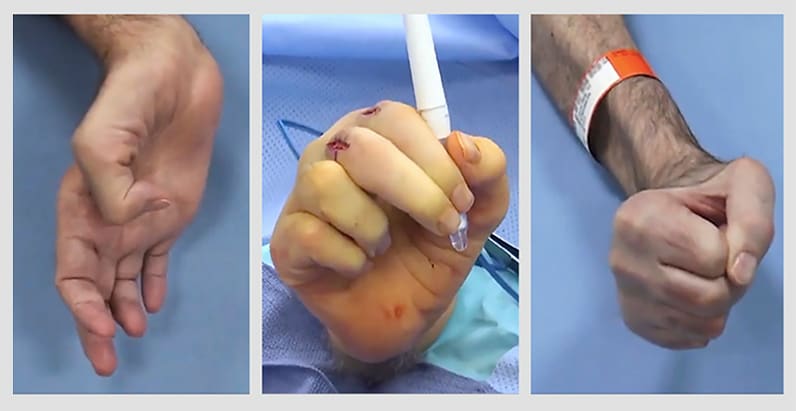Sept. 18, 2018
Patient's hand pre- and post-surgery

Patient's hand pre- and post-surgery
The hand of a patient with long-term tetraplegia, before, during and after surgery.
Mayo Clinic is one of the few centers in the United States that offers upper extremity reconstruction for people with tetraplegia. The procedure, which uses standard hand surgical techniques, can help restore hand function and increase patients' independence after a spinal cord injury.
"There isn't a lot of awareness of this option. Many people can benefit from this surgery, but only about 10 percent of patients who are candidates actually get it," says Peter C. Rhee, D.O., a hand surgeon at Mayo Clinic's campus in Rochester, Minnesota.
Multiple studies have shown that people with tetraplegia prioritize hand function over other functions, such as walking and bowel and bladder control. Outcomes from reconstructive surgery depend on the patient's level of injury and degree of disability. Upper extremity reconstruction uses a combination of joint fusions, tenodesis, and tendon and nerve transfers. Mayo Clinic's experience and expertise allow for the performance of these procedures in patients with tetraplegia.
"We are using techniques similar to ones we've done for years with brachial plexus or peripheral nerve injuries," Dr. Rhee says. "What's different about applying those techniques to patients with tetraplegia is their mixed nerve injury pattern. Most hand surgeons don't have experience treating higher level nerve injuries that originate in the brain or spinal cord."
The surgery generally takes all day and requires an overnight hospital stay. Patients leave the following day with instructions for a structured rehabilitation program they can do at home. Mayo Clinic specialists are available to answer questions by telephone between follow-up visits.
Because of the extensive post-surgical rehabilitation, Mayo Clinic selects candidates for upper extremity reconstruction carefully, based on their ability and willingness to complete follow-up therapy. "These patients have already experienced acute spinal injuries. They spend three to six months recovering and learning to cope with the injury. The upper extremity reconstruction requires another two or three months of rehabilitation, and for many patients that feels like a step backward," Dr. Rhee says.
A team approach is used for all patients with tetraplegia. "What makes Mayo Clinic unique is that we focus on the whole patient, to improve outcomes," Dr. Rhee says. "We immediately set a patient up with a urologist who deals only with neurogenic bladders, a neurologist to assess spinal cord health, a physiatrist who manages the spinal cord injury and a psychologist who specializes in people with spinal cord injuries."
Dr. Rhee's interest in upper extremity reconstruction began during his military service as a hand surgeon, when he treated patients with severe brain and spinal cord injuries. "I realized there are surgical options that aren't offered very often due to the complexity of the patient's neurologic injury and the rarity of performing these procedures," he says. Mayo Clinic supported his interest when he returned from active duty.
Dr. Rhee cites a patient who had tetraplegia for decades before having upper extremity reconstructive surgery. At a post-surgical checkup, the patient gave Dr. Rhee his right hand. "It was a really nice grip," Dr. Rhee says. "He told me it was the first time in 40 years that he had used his right hand to shake hands.
"Almost anyone with upper motor neuron syndrome due to a spinal cord injury, cerebrovascular accident, or traumatic or anoxic brain injuries can benefit at least from an evaluation to learn the options that are available," he adds. "At Mayo Clinic, we have a system to provide that."